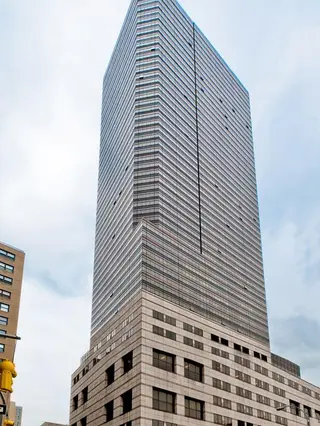 Carter Horsley
Carter HorsleyMar 20, 2012
Carter's Review
One of the more interesting high-rise projects in the Lincoln Center district, this mixed-use complex, which is known as Three Lincoln Center and 160 West 66th Street, has one of the most elegant and most visible condominium apartment buildings on the Upper West Side.
There are 347 condominium apartments in the 54-story, black-glass tower with thin red banding. The complex also includes a 17-story, white-stone tower that is closest to the rest of the performing arts center and contains a variety of facilities for the center including dormitories for the Juilliard School and the School of American Ballet.
The complex was built by Allan and Abbot L. Stillman and Birchall Associates.
The complex was designed by Davis, Brody & Associates.
Bottom Line
Sited on the northwest corner of the Lincoln Center for the Performing Arts campus, Three Lincoln Center has many units with vistas of the Hudson River as well as the famous cultural complex. The sleek, dark glass tower is one of the most handsome in the city and also is a bit removed from the center’s hustle and bustle at curtain times.
Description
The complex is divided into two very distinct sections. The low-rise structure, comprising the Samuel and David Rose Building, faces east and is clad in white stone to blend in with the façades of Lincoln Center while the high-rise section fronting on Amsterdam Avenue is clad in black glass with red ribbing.
The high-rise tower, which maintains it is 60 stories tall, is beautifully detailed and one of the city's most attractive glass "curtain-walls."
The building has two lobby entrances. The main entrance is at 160 West 66th Street, west of Broadway, and a second entrance is from the performing arts complex. The lobby is richly appointed in mahogany, cherry and Danish beech woods.
The tower’s southeast corner is chamfered to lessen the building’s visual bulk.
Amenities
A concierge desk is staffed 24 hours a day and linked to every residence with a computerized audio-visual system. Doorman service also is around the clock.
The Center Club for residents includes a 60-foot heated swimming pool, sauna and steam room, showers, an aerobics facility with a specially engineered flexible floor, as well as a reception room and adjacent catering kitchen.
The building has a children’s playroom, a party room, and a garage and it is pet friendly.
The condominium tower’s street-level lobby is connected by escalators to the third-floor level of the Juilliard School’s plaza, giving residents access to the center’s various venues.
Apartments
Because residences begin on the 16th floor, they each enjoy majestic views. The homes range in size-up to 3,600 square feet.
The building also has some studios and some duplex apartments.
A three-bedroom apartment has an 18-foot-long living room with an adjoining 12-foot-long dining area and an enclosed kitchen.
A two-bedroom apartment has a 15-foot-long foyer that leads into a very large living room with an open kitchen that faces southeast.
A four-bedroom apartment on the 42nd floor has a large foyer that leads into the large corner living room that is adjoined an enclosed kitchen and a dining room with a wine cellar that leads to an office with a Jacuzzi.
Apartment 59D is a two-bedroom unit with an angled living/dining/den area that is 38 feet long with an enclosed kitchen.
History
The project was first announced in 1984.
When it was completed in 1993, the project consisted of the black condominium tower, 44 stories on top of a 10-story base, and a white, 17-story Samuel B. and David Rose Building that houses dormitories for 350 students of adjoining Juilliard School and the School of American Ballet, and a home for the newly established Lincoln Center Film Society.
The residence hall in the shorter building is named after the composer Meredith Willson and has two music practice rooms on each floor and near the top of the building is a reception room with 16-foot-high ceilings. The building is also home to the Walter Reader Theater, the principal venue of the center’s film program.
The condominium tower incorporates an existing firehouse on the southeast corner at 66th Street and Amsterdam Avenue and space for a new Riverside branch of the New York Public Library. David Brody was the architect for the complex and Harman Jablin did the interiors of the condominium tower.
In a July 28, 1991 article in The New York Times, Paul Goldberger wrote that the condominium tower was a “small price to pay for a shot of cultural adrenaline” – the facilities for the center in the shorter building. He added that the condominium tower “is about as deferential as a 60-story skyscraper can be” and “is the classiest condominium tower in the neighborhood, as befits Lincoln Center.”
The developers paid Lincoln Center $48.5 million for the site’s air rights.

- Condo built in 1993
- 4 apartments currently for sale ($1.65M to $2.65M)
- 1 apartment currently for rent ($0)
- Located in Lincoln Center
- 347 total apartments 347 total apartments
- 10 recent sales ($880K to $5.8M)
- Doorman
- Pets Allowed
 6sqft delivers the latest on real estate, architecture, and design, straight from New York City.
6sqft delivers the latest on real estate, architecture, and design, straight from New York City.
